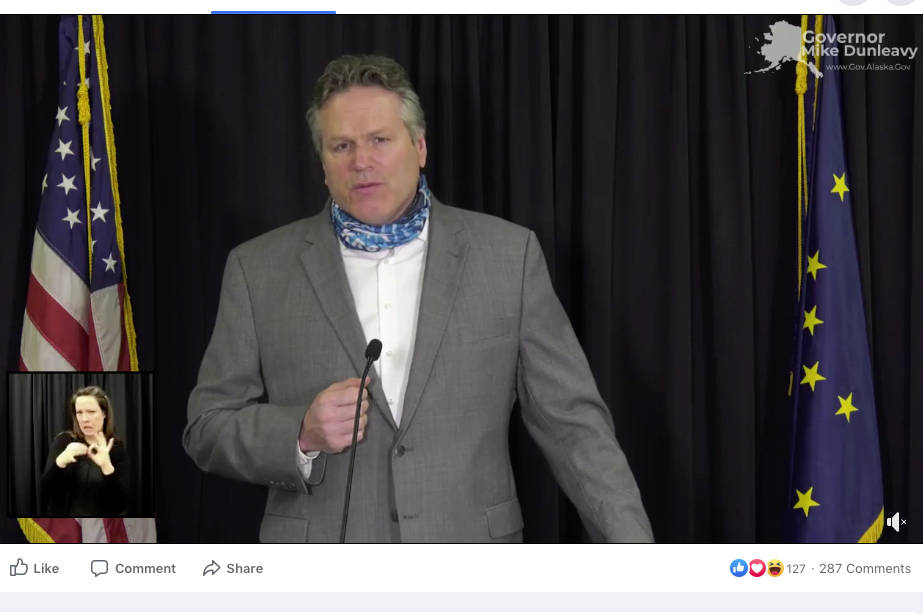Gov. Mike Dunleavy announced Tuesday that he will split the Alaska Department of Health and Social Services into two departments via executive order to help improve the way the departments are managed.
The two new departments would be the Alaska Department of Health and the Alaska Department of Family and Community Services. According to a press release from the governor’s office, breaking up DHSS will streamline and improve how critical programs are delivered to Alaskans and will allow for more flexibility and responsiveness. There are currently 10 divisions included in DHSS.
“We want government to perform better,” Dunleavy said. “We’re not eliminating any programs through this executive order. What we want to do is split it out so it can be managed better.”
The Department of Family and Community Services will specifically target early intervention and prevention for families and for individual Alaskans. Divisions under the department will include the Division of Juvenile Justice, the Office of Children’s Services, the Alaska Psychiatric Institute and Alaska Pioneer Homes.
The Alaska Department of Health will focus on “whole person care” by “leveraging evidence based, data driven practices and care models to make the most appropriate care to recipients at the appropriate cost.” Divisions under the department will include the Division of Senior & Disability Services, the Division of Behavioral Health, the Division of Public Health, the Division of Public Assistance and the Division of Health Care Services.
Both departments will have a division for Finance & Management Services.
Dunleavy has directed the Alaska Department of Law to draft the order, which will be submitted to the Alaska Legislature when they convene on Jan. 21. So long as the Legislature does not disapprove of the order during the 60 days it is allowed to deliberate it, the order will become law and take effect on July 1, 2021.
Dunleavy said on Tuesday that the state is not expecting to incur costs from the reorganization.
During the conference, Dunleavy was joined by Alaska’s Chief Medical Officer Dr. Anne Zink and DHSS Commissioner Adam Crum.
Zink provided updates on distribution of the COVID-19 vaccine in Alaska. As of Dec. 21, 7,118 doses of Pfizer’s vaccine had been administered in Alaska. On Monday, the state received its first shipment of doses of Moderna’s COVID-19 vaccine, which the state is expecting to be logistically easier to handle and to distribute. In total, Alaska is expecting to receive 26,800 initial doses of the Moderna vaccine.
Both the Pfizer and Moderna vaccines, which have efficacy rates of more than 90%, require two doses to be fully effective. Pfizer’s doses must be administered 21 days apart, while Moderna’s doses must be administered 28 days apart. Doses sent to states are initial doses. The second doses of Pfizer and Moderna’s vaccines are being withheld at the federal level and will be sent to states at a later date.
On Monday, DHSS said in a media press conference that the next group of individuals to receive the COVID vaccine will include workers in health care settings who are at highest risk of contracting COVID-19, who are essential to health care infrastructure and who provide health care services that cannot be postponed or offered remotely. Vaccine administration for people in this group is expected to begin on Jan. 4.
As vaccine supply remains limited, DHSS is encouraging Alaskans to continue practicing COVID-19 mitigation protocols such as frequent hand-washing, keeping 6 feet of distance between themselves and people who are not from their household and to wear a mask or face covering when social distancing is not possible.
More information about COVID-19 vaccines in Alaska and DHSS’ vaccine distribution plan can be found on covidvax.alaska.gov.
Dunleavy’s full Tuesday press conference can be viewed on the governor’s Facebook page.
Reach reporter Ashlyn O’Hara at ashlyn.ohara@peninsulaclarion.com.

